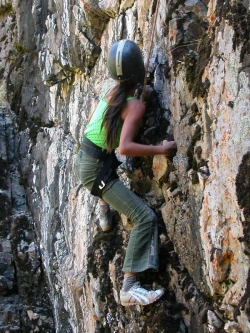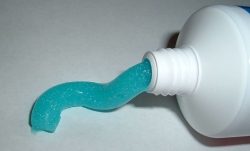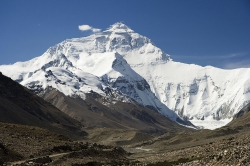Have you ever seen really tall cliffs? Maybe you have gone rock climbing or you have seen big rock cliffs by the beach. These big rocks may look really solid, but if you looked closer at them you would see that they are made of smaller chunks of rock. You might also see that there are lots of cracks in the cliffs. If you were rock climbing on these cliffs, you would most likely be happy to see these cracks because they would give you something to grab on to. You probably will not be able to make a new hole or crack in the rocks. And if you could, well, then all your friends might be a little scared of you! Instead, most of the rocks we see are broken apart with a force much greater than a push from your arms and legs.

They say the view from the top is amazing!
Jabez at en.wikipedia, Public domain, via Wikimedia Commons
Of course, since this is science, there is a special name for the thing that breaks apart rocks. Force is a push or pull on something. You use force every day to move around. You use it when you take the lid off a jar of jelly. You use it when you squeeze paste on your toothbrush in the morning. In fact, if you are not using force to brush your teeth every day, then your friends will not be very happy with you!

It's going to take a lot of work but I'm going to have such clean teeth!
Scott Ehardt, Public domain, via Wikimedia Commons
If something pushes on rocks for a long time, it will break them apart. This brings us to our next special science word. Weathering is the breaking apart of rocks. This can mean that big rock cliffs have little bits of rock fall off them. It can also mean that sharp rocks in a creek get smoothed out when water runs over them and slowly breaks them down. In both cases, rock is being broken down. There are some other ways that rocks are broken apart. One is called mechanical weathering. Mechanical weathering is when rocks are broken up with force. In other words, mechanical weathering uses pushing and pulling to break up rocks.
Of course, there needs to be something using force to break up rocks. There are many different things that can help do this job. Sometimes things that might seem really weak actually have enough force to break apart rocks. For example, think of tree roots breaking up a sidewalk. Even though it might make you trip when you walk over a broken up sidewalk, the power of the tree roots is pretty cool! Over many years, those roots slowly grew into the ground and pushed out. Even though they start as tiny roots, they have to grow strong to hold the huge tree down.

Tree roots and sidewalk: nature's skateboard park.
Water is another force that can break up rocks. Water that has been frozen into ice can push on rocks hard enough to make them break apart. Have you ever put a soda can into the freezer to make it cold fast, but then forgot about it? If so, you probably ended up with a cracked can of soda and a mess in your freezer. It works the same way when water gets into tiny cracks in rocks and freezes into ice. Ice wedging is when the force of frozen water (ice) pushes rocks apart. The ice pushes on the rocks as it grows bigger and this forces the rocks to crack and break apart. Think of water as being like a weak guy and think of ice as being like that weak guy after he has been working out for a few years. Only the ice, not the plain water, is strong enough to push apart the rock.

Ice has been breaking down Mount Everest for thousands of years. It still stands as the highest peak in the world.
Photo by Luca Galuzzi
One of the other things that has enough force to break rocks is salt. Now, when you look at the salt on your table you might not think of it as very strong, but if you had a big piece of salt, you also would not be able to tear it apart with just your hands. When the salt you put on your food is formed, it makes crystals. When this happens, the salt pushes rocks apart by getting into small cracks in the rocks and growing. Salt wedging is when the force of growing salt crystals pushes rocks apart.
You may be wondering how salt gets into the rock cracks in the first place. After all, it is not like you have ever seen salt falling from the sky like rain! Actually, the salt does "rain" down into the rocks. Water has different minerals in it, and sometimes when water gets into the cracks in rocks, the water dries up and leaves behind the minerals. These then grow into salt crystals, which can then push, or wedge, apart the rocks.
Want to go over what we just learned? Here we go: Weathering is the big name for "breaking rocks." Mechanical weathering works through using force, which is just a fancy name for pushing or pulling. Ice, salt, and tree roots are some of the things that use force to do the job of breaking apart rocks. One way to think about all of this is to think of mechanical weathering as the boss of a company that breaks rocks. Ice, salt, and tree roots are the workers in the company, and they have to do the hard work of breaking up rocks. Force comes from the tools -- ice, salt, tree roots -- that the workers use to do their jobs.